Pumping Station Desing - Second Edition by Robert L. Sanks, George Tchobahoglous, Garr M. Jones
Подождите немного. Документ загружается.

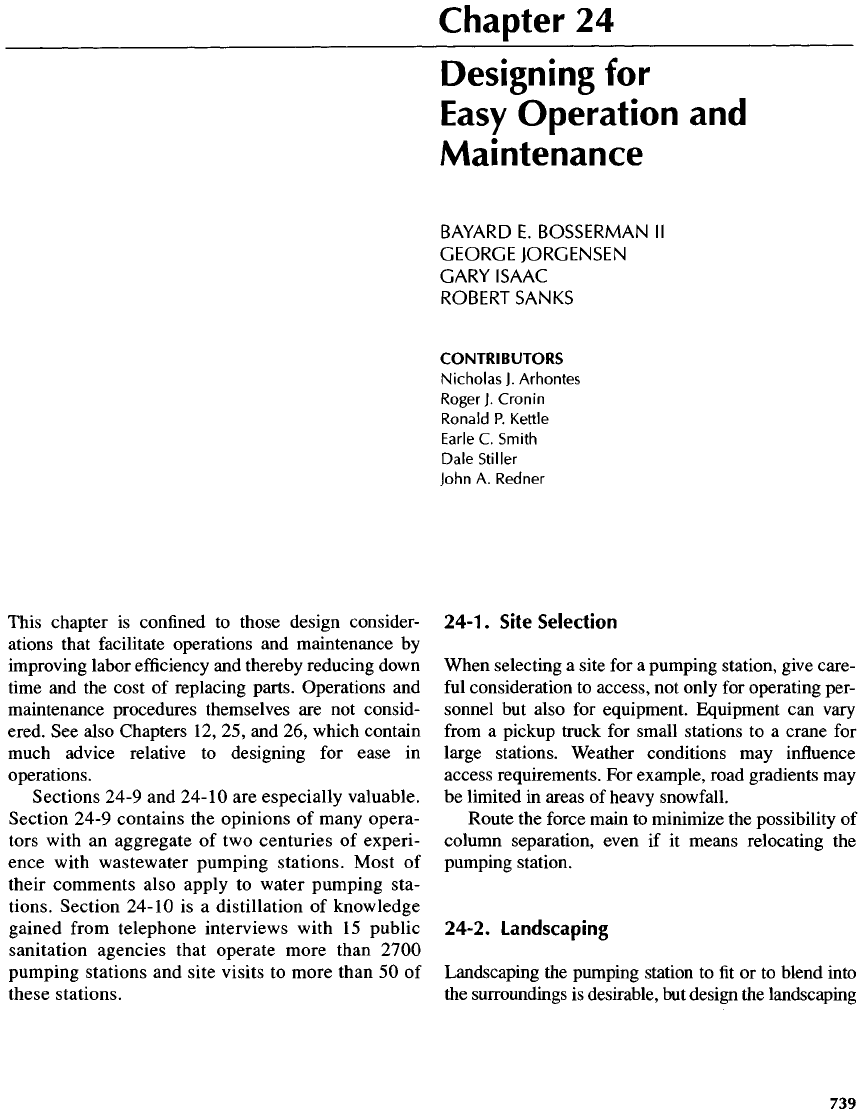
This chapter
is
confined
to
those design consider-
ations
that facilitate operations
and
maintenance
by
improving
labor
efficiency
and
thereby reducing down
time
and the
cost
of
replacing parts. Operations
and
maintenance procedures themselves
are not
consid-
ered.
See
also Chapters
12, 25, and 26,
which contain
much
advice relative
to
designing
for
ease
in
operations.
Sections 24-9
and
24-10
are
especially valuable.
Section 24-9 contains
the
opinions
of
many opera-
tors with
an
aggregate
of two
centuries
of
experi-
ence
with wastewater pumping stations. Most
of
their comments also apply
to
water pumping sta-
tions. Section 24-10
is a
distillation
of
knowledge
gained
from
telephone interviews with
15
public
sanitation agencies that operate more than
2700
pumping
stations
and
site visits
to
more than
50 of
these stations.
Chapter
24
Designing
for
Easy
Operation
and
Maintenance
BAYARD
E.
BOSSERMAN
Il
GEORGEJORGENSEN
GARY
ISAAC
ROBERT
SANKS
CONTRIBUTORS
Nicholas
J.
Arhontes
Roger
J.
Cronin
Ronald
P.
Kettle
Earle
C.
Smith
Dale
Stiller
John
A.
Redner
24-1.
Site
Selection
When selecting
a
site
for a
pumping station, give care-
ful
consideration
to
access,
not
only
for
operating per-
sonnel
but
also
for
equipment. Equipment
can
vary
from
a
pickup truck
for
small stations
to a
crane
for
large stations. Weather conditions
may
influence
access requirements.
For
example, road gradients
may
be
limited
in
areas
of
heavy snowfall.
Route
the
force main
to
minimize
the
possibility
of
column
separation, even
if it
means relocating
the
pumping station.
24-2.
Landscaping
Landscaping
the
pumping station
to fit or to
blend into
the
surroundings
is
desirable,
but
design
the
landscaping

for
low
maintenance
by
using ornamental woody peren-
nials
and
ground cover that require little attention.
Install
automatic sprinkler systems activated
by
mois-
ture
probes
and a
timer.
24-3.
Hydraulics
The
hydraulics
of
pumping systems
are
covered
in
several
other
chapters,
but it is
worth repeating that
if the
analyses
are
improper, inadequate,
or do not
include
all of the
operating conditions (including start-up, shut-down,
and
power
failure),
excessive maintenance
may
result.
Head-Capacity
Curves
A
careful
study
of the
full
range
of
conditions under
which
pumping will occur
is
essential
so
that
the
proper pump, impeller,
and
motor
can be
chosen.
Such
a
study
is
particularly needed where
a
battery
of
pumps
discharges into
a
manifold.
As
additional
pumps
come
on
line,
the
total
flow and
head increase,
but
as the
head increases,
the flow
from
each individ-
ual
pump decreases.
In a
smaller pump
(or one
with
a
lower
shut-off
head than
the
others),
the
discharge
may
drop
to
zero, which
can
cause excessive radial
loads.
If the
analysis
is
incomplete,
the
pumping con-
ditions
may be
outside
the
limits
of the
pump curve
for
a
particular pump (refer
to
Section 10-6).
Pressure
Gauges
Taps
(in
bronze pipe saddles secured
to the
pipe with
double
bronze
or
stainless-steel straps)
for
screw con-
nections
of
pressure gauges
are
useful
on
both
the
intake
and
discharge pipelines. Permanently mounted pressure
gauges
can be
used,
but
portable gauges, which
can be
used
when needed,
are
usually better because they
can
be
easily recalibrated
and can
serve
for
many locations
(see Chapter 20). Fixed gauges
are
subject
to
equipment
vibration and, unless periodically recalibrated, will
not
remain
reliable.
The
maintenance schedule should
require pressure readings
at
regular intervals (e.g.,
monthly)
along with simultaneous
flowmeter
readings.
These records
can be
used
to
detect abnormalities such
as
clogging
of the
force
main
or
impeller wear.
Flow
Measurement
To
check
the
efficiency
of the
pumping system,
a
flowmeter
in
conjunction with
the
pressure gauges
facilitates
checking
the
power consumed against
the
water output.
It is
also
a
good idea
to
make
it
easy
to
calibrate
the flowmeter in
place;
for
water systems,
a
means
of
inserting
a
pitot tube
is a
good
way to do so.
Time-volume measurements using
the wet
well,
a
storage tank,
or a
clear well
are
reliable
and can
often
be
used.
The use of
tracers (dye dilution)
is
accurate,
almost universally applicable,
and
easy
to use if
taps
(one
to
introduce
the
tracer
and
another
at a
point
far
downstream
for
withdrawing samples)
are
installed
(see Section 3-9).
The
lengths
of
straight inlet
and
outlet pipe recom-
mended
by the
manufacturer must
be
observed
for all
types
of
meters; otherwise
the
meter readings will
probably
be
erroneous.
The
errors increase exponen-
tially
as the
inlet
and
outlet pipes
are
shortened.
Surge
Control
Water hammer need
not
instantly rupture
a
pipe
to be
damaging. Surges that continue
for
many years gradu-
ally
destroy
a
pipe's
integrity through material
fatigue,
so
surge control
is
required
in
most pumping stations
to
prevent damage
to the
piping system. Several meth-
ods of
surge control
can be
employed:
•
Pump-control valves (which
are
popular)
for
start-
up
•
Motor starters that ramp
up and
down when pumps
are
started
or
stopped
•
Flywheels
to
control
the
rates
of
acceleration
or
decay
of
liquid system velocities.
These
and
other methods
are
discussed
at
length
in
Chapter
7.
Neither
of the first two
methods, however,
provides
any
surge control
for
power
failure.
As
explained
in
Chapter
7, if the flowrate
exceeds about
30 L/s
(500
gal/min)
and the
total dynamic head
exceeds
12 or 15 m (40 or 50
ft),
a
surge control anal-
ysis
is
needed
and
other surge control devices
or
sys-
tems
may be
required.
If
surge
can
occur
in the
intake pipe, consideration
must
be
given
to
surge control both
in the
discharge
and
intake piping.
Air-Vacuum
Release
Valves
Try
to
avoid
the
need
for
air-vacuum
release valves
in
water
service (and make every
effort
to
avoid them
in
wastewater
service) because they become unreliable
if
not
properly maintained. Because these valves seldom
receive
the
maintenance required
to
ensure 100% reli-
ability
and
because
no
designer
can
guarantee proper

maintenance
in the
future,
relying
on
air-vacuum
release valves
to
positively prevent water hammer
is
unwarranted.
If a
water hammer control device
can
fail,
it
will
do so
sometime
and is,
therefore, inade-
quate
protection.
Use
other defensive strategies, such
as
alternate pumping locations and/or
a
suitable force
main
profile
obtained
by
relocation,
deep
trenching,
or
even tunneling.
If
necessary,
increase
the
rotational
inertia
of the
pump
and
motor
by
adding
a
flywheel.
If
alternatives
are
completely impractical, conduct
a
careful
analysis
of the
system
for the
proper size
of
air-
vacuum
release
valve openings. Always install such
valves
in
pairs, particularly
in
sewage systems,
to
pro-
vide
a
backup
if one
fails.
Use the
tall type
and
stain-
less-steel trim
for
sewage service.
If
iron valve bodies
are
used, require
an
epoxy coating
to
prevent corrosion.
Provide
flushing
facilities
for all air and
vacuum
release
valves
and
specify
weekly maintenance
in the O&M
manual.
Note that only
an air or a
vacuum release valve
might
be
needed instead
of the
combination.
Intake
Sumps
Follow
the
recommendations given
in
Sections 12-6
and
12-7
in
designing clear water
and
(especially)
wastewater
wet
wells. These designs provide nearly
ideal hydraulic environments
for
pump intakes,
and
with
only
the
added cost
of an
ogee spillway
in
storm
water stations plus (for wastewater stations)
a
small
(1.5
to 4.5 L/s or 25 to 70
gal/min)
wash
water hose,
they
can be
easily
and
quickly cleaned.
For
clean waters, some engineers
may
prefer
to
follow
the
designs
in
Hydraulic Institute Standards
of
1983
[1] or in the
later
ANSI/HI
Standards [2,3],
but
beware! Those designs
are
unsuitable
for
water con-
taining
either settleable
or floating
debris, because,
without
modification, they cannot easily
be
cleaned.
(Mixing
the
contents during pumping
is one
modifica-
tion
that
is
sometimes
effective,
but
designers should
contact manufacturers that make equipment
specifi-
cally
for
that purpose.)
If
there
are
unusual
conditions
or if the flow is
very
large, model studies should
be
used
to
optimize
the
geometry
and the
need
for
baffles
and
suppression
of
swirling
and
vortices.
If
practical, provide enough storage
in the wet
well
and
influent
sewer
so
that short-term (e.g.,
1 h)
power
outages
can,
at
least
for
dry-
weather
flows,
occur
without
damage.
Heat
generated
by
inrush current during start-ups
can
damage motors.
The
sump should
be of
adequate
size
to
limit
the
starts
per
hour
to the
manufacturer's
recommendation.
24-4. Mechanical Considerations
One of the
most costly elements over
the
life
of the
facility
is
maintenance labor. Hence, developing
a
concept
or
method
for the
disassembly
of
piping,
pumps,
check valves, gate valves, traps,
flowmeters,
and
so on for
maintenance
or
removal
and
replace-
ment
is
important, even
if
three-dimensional
drawings
or
spatial models
are
necessary. Include such plans
in
the O&M
manual.
The
following guidelines make
the
maintenance
or
replacement
of
pipe,
fittings, and
pumps
easy:
•
Locate these elements
at a
convenient height.
•
Orient them
so
that removing
the
covers does
not
drench
the
workers.
•
Include
a
drain
and a
vacuum cock
for
emptying
the
pipe.
•
Install strong,
safe,
lifting
eyes
in the
ceiling
for a
chain hoist
in
small stations, monorails
and
electric
hoists
for
small
to
medium stations,
and
traveling
bridge cranes
for
large stations. Even
in
small sta-
tions, consider
a
trolley rail
for
moving
the
heaviest
load
to a
hatch accessible
to the
upper-level hoist.
Hoists should travel over
all
heavy equipment
and
terminate
at a
doorway. Alternatively, especially
for
vertical turbine pumps, install roof hatches
for
access
by
a
mobile crane parked outside.
The
hatches
and
floor
space must
be
adequate
for
removing
the
largest
equipment.
It is bad
practice
to
build
the
upper part
of
the
station around equipment already
in
place.
•
Provide plenty
of
clearance [0.8
m (30
in.) mini-
mum,
1 m (36
in.) recommended] between
the
pip-
ing and
pumps
or
other equipment
for
workers
and
their wrenches
and
other tools. Make sure that nuts
and
bolts
are
accessible. Increase
the
clearance
for
larger pumps. There must
be
adequate space under
the
crane
or
hoist
to lay
removed parts
on the floor.
•
Design
the
piping with enough sleeve and/or
grooved-end couplings
to
permit
the
easy removal
of
pumps, valves, etc. Blocking,
tie
downs,
or
bri-
dles
are
required
for
sleeve couplings.
•
Provide valves
to
isolate pumps
so
that
any
pump
can be
removed without draining
the
header
and
force
main.
•
Specify
spacer
shafts
between pumps
and
motors
to
allow
for the
quick
and
easy removal
of
backheads
and
rotors
of end
suction pumps
to
make replace-
ment
of
seals,
shaft
sleeves,
and
wearing
rings
easy
without
moving
the
motor
or
pump.
•
Provide
a
spool
of the
same length
as the flowmeter
and
shut-off
valves
on the
header
to
permit
the
removal
of the flowmeter. An
alternative arrange-
ment
is
depicted
in
Figure
20-12.

•
Provide adequate lighting
for
safe
working condi-
tions.
•
Install GFCI protection
on all
service receptacles.
Locate
the
following items
in
places that
are
easily
accessible
for all
routine maintenance:
•
Traps that must
be
periodically cleaned
•
Pump vent piping
•
Grease
fittings
(especially intermediate bearings
on
long
shafts)
•
Intermediate bearings
on
long
shafts
(safely
acces-
sible)
• Oil
reservoirs
•
Dry-break, quick-connect couplings
on
hydraulic
hoses
•
Dehydrating canisters
•
Mechanical
or
electrical devices that need periodic
adjustment.
If
necessary, provide permanent steps and/or plat-
forms
for
access.
Miscellaneous
considerations include
the
following:
•
Keep walking areas clear
of
overhead obstructions
to a
height
of at
least
2.2 m (7
ft).
If
obstructions
cannot
be
eliminated, cover them with padding
and
hang
warning devices (heavy strings
or
light chains,
for
example)
on
both sides.
•
Install convenient hose bibbs.
A
proper
backflow
preventer
must
be
installed
on the
potable water
connection
to the
station.
•
Install
a
lavatory
or at
least
a
wash basin.
•
Provide access
that
complies
with
OSHA require-
ments
to
ladders
and
manhole steps.
•
Provide adequate storage space
for
spare lubricants,
parts,
and
special tools.
Nine
power plants were surveyed
by the
Electric
Power Institute
to
identify
problems that
affect
pro-
ductivity
and the
safety
of
maintenance personnel
[4].
The
suggestions made
are
also
useful
for
pumping sta-
tion
designers. They include
the
following:
•
Provide easy
access
to
adjustment points,
test
points,
and
filling
and
draining locations
on all
equipment.
•
Arrange equipment
so
that access
to the
malfunc-
tioning
unit
does
not
require
the
disassembly
of
adjacent
units.
•
Provide
sufficient
clearance
to
allow
for
effective
personnel interaction when
a
team
effort
is
required.
•
Ensure that equipment clearances
in
hazardous
areas allow access
by
personnel encumbered
by
protective
garments
and
associated gear.
•
Provide
a
clearance
of at
least
l.lm
(42
in.)
at the
front
or
back
of
electrical panels.
•
Code
or key
interchangeable units that
are
function-
ally
dissimilar
to
prevent their insertion
in the
wrong
unit.
•
Provide places
to put and
support components
being removed
or
installed.
• Use
hinged doors rather than cover plates (which
are
time consuming
to
remove) where
frequent
access
is
needed.
•
Place controls
and
associated instrumentation
within
easy visual
and
manual reach
of
normal
work
positions.
A
universal complaint
was the
difficulty
of
accessing
equipment that required attention. About
30% of the
maintenance time could have been saved
had
ideal
or
unrestricted access been possible.
Remember that some types
of
equipment (e.g.,
submersible well pumps
and
submersible
wet pit
sew-
age
pumps)
are
maintenance intensive
and
must
be
removed
and
reconditioned
at
regular intervals,
and
this
may
cost about
one
third
as
much
as a new
pump.
Parts
for
some kinds
of
equipment (e.g., variable-fre-
quency
drives
and
some foreign-made pumps)
are
very
expensive
or,
worse yet,
may be
available only
after
long delays. Investigate this aspect before using
such equipment
and
conduct lifetime present-worth
analyses
of the
maintenance labor
and
parts
as
well
as
of
the
costs
for
energy. Avoid considering only
the
first
cost.
24-5.
Electrical
Considerations
According
to the
NEC, electrical control panels must
have
a
minimum clearance
in
front
of at
least
• 0.9
Im
(3 ft) for O to
15OV
•
1.07
m (3 ft, 6
in.)
for 151 to 600 V
•
1
.22
m (4 ft) for 601 to
2500
V
•
1
.52
m (5 ft) for
2501
to
9000
V.
The
same clearance
is
required
at the
back
if the
panel
is
a
free-standing unit. Free-standing panels
are
rec-
ommended over wall-mounted
panels.
A
lock-out stop should
be
installed
at
each motor
(or
at any
rotating equipment) that cannot
be
seen
from
the
control panel
to
prevent accidental energiza-
tion
while
the
equipment
is
being serviced.
A
time-
running meter
for
each pump
can
furnish
useful
infor-
mation
for
scheduled maintenance. Include heaters
or
desiccant containers
(to
keep electrical equipment
dry)
and put
control panels
in a
location
free
from
dust,
fumes,
and
H
2
S.
For
large pumping stations, consideration should
be
given
to
computerization
for
monitoring
and
con-
trolling
the
system.
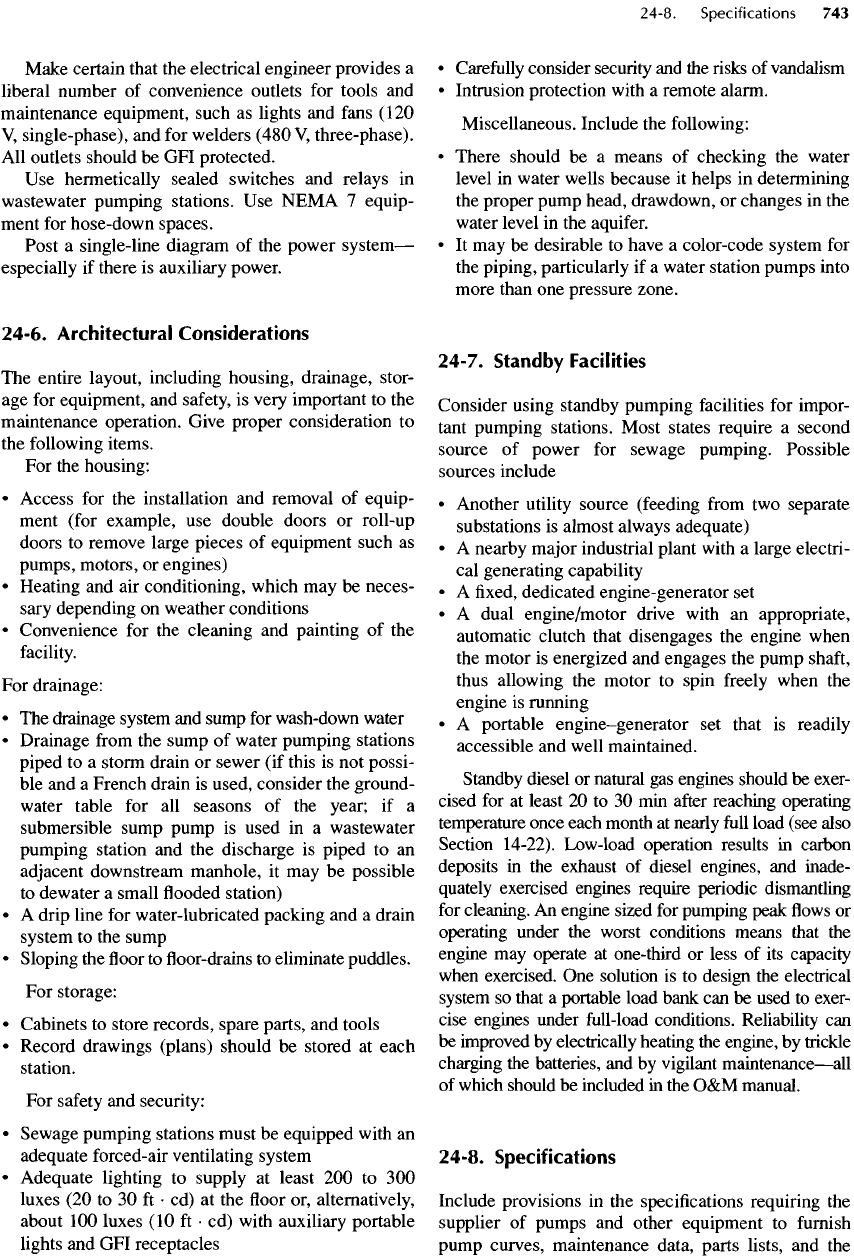
Make certain that
the
electrical engineer provides
a
liberal number
of
convenience outlets
for
tools
and
maintenance equipment, such
as
lights
and
fans
(120
V,
single-phase),
and for
welders (480
V,
three-phase).
All
outlets should
be GFI
protected.
Use
hermetically sealed switches
and
relays
in
wastewater pumping stations.
Use
NEMA
7
equip-
ment
for
hose-down
spaces.
Post
a
single-line diagram
of the
power
system
—
especially
if
there
is
auxiliary power.
24-6. Architectural Considerations
The
entire layout, including housing, drainage, stor-
age for
equipment,
and
safety,
is
very important
to the
maintenance operation. Give proper consideration
to
the
following items.
For the
housing:
•
Access
for the
installation
and
removal
of
equip-
ment (for example,
use
double doors
or
roll-up
doors
to
remove large
pieces
of
equipment such
as
pumps,
motors,
or
engines)
•
Heating
and air
conditioning, which
may be
neces-
sary
depending
on
weather conditions
•
Convenience
for the
cleaning
and
painting
of the
facility.
For
drainage:
• The
drainage system
and
sump
for
wash-down water
•
Drainage
from
the
sump
of
water pumping stations
piped
to a
storm drain
or
sewer
(if
this
is not
possi-
ble and a
French drain
is
used, consider
the
ground-
water table
for all
seasons
of the
year;
if a
submersible sump pump
is
used
in a
wastewater
pumping
station
and the
discharge
is
piped
to an
adjacent
downstream manhole,
it may be
possible
to
dewater
a
small
flooded
station)
• A
drip line
for
water-lubricated packing
and a
drain
system
to the
sump
•
Sloping
the floor to floor-drains to
eliminate puddles.
For
storage:
•
Cabinets
to
store records, spare parts,
and
tools
•
Record
drawings (plans) should
be
stored
at
each
station.
For
safety
and
security:
•
Sewage pumping stations must
be
equipped with
an
adequate forced-air ventilating system
•
Adequate lighting
to
supply
at
least
200 to 300
luxes
(20 to 30 ft • cd) at the floor or,
alternatively,
about
100
luxes
(10
ft • cd)
with auxiliary
portable
lights
and GFI
receptacles
•
Carefully
consider security
and the risks of
vandalism
•
Intrusion protection with
a
remote alarm.
Miscellaneous. Include
the
following:
•
There
should
be a
means
of
checking
the
water
level
in
water wells because
it
helps
in
determining
the
proper pump head, drawdown,
or
changes
in the
water level
in the
aquifer.
• It may be
desirable
to
have
a
color-code
system
for
the
piping, particularly
if a
water station pumps into
more than
one
pressure zone.
24-7. Standby
Facilities
Consider using standby pumping facilities
for
impor-
tant
pumping stations. Most states require
a
second
source
of
power
for
sewage pumping.
Possible
sources include
•
Another utility source (feeding
from
two
separate
substations
is
almost always adequate)
• A
nearby major industrial plant with
a
large electri-
cal
generating capability
• A fixed,
dedicated engine-generator
set
• A
dual engine/motor drive with
an
appropriate,
automatic clutch that disengages
the
engine when
the
motor
is
energized
and
engages
the
pump
shaft,
thus
allowing
the
motor
to
spin
freely
when
the
engine
is
running
• A
portable
engine-generator
set
that
is
readily
accessible
and
well maintained.
Standby
diesel
or
natural
gas
engines should
be
exer-
cised
for at
least
20 to 30
min
after
reaching operating
temperature once each month
at
nearly
full
load (see also
Section 14-22). Low-load operation results
in
carbon
deposits
in the
exhaust
of
diesel engines,
and
inade-
quately
exercised engines require periodic dismantling
for
cleaning.
An
engine sized
for
pumping peak
flows or
operating under
the
worst conditions means that
the
engine
may
operate
at
one-third
or
less
of its
capacity
when
exercised.
One
solution
is to
design
the
electrical
system
so
that
a
portable load bank
can be
used
to
exer-
cise engines under
full-load
conditions. Reliability
can
be
improved
by
electrically heating
the
engine,
by
trickle
charging
the
batteries,
and by
vigilant
maintenance
—
all
of
which should
be
included
in the O&M
manual.
24-8. Specifications
Include provisions
in the
specifications requiring
the
supplier
of
pumps
and
other equipment
to
furnish
pump
curves, maintenance data, parts lists,
and the
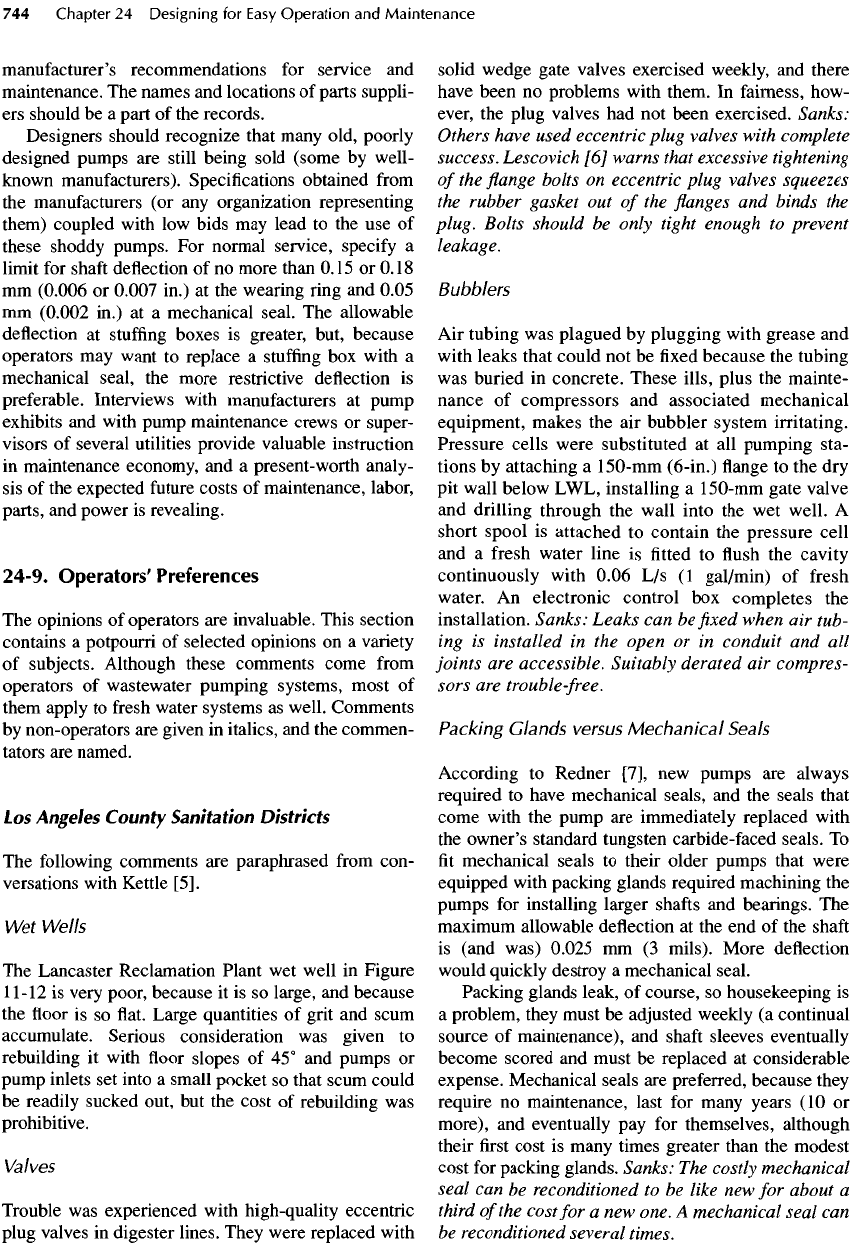
manufacturer's
recommendations
for
service
and
maintenance.
The
names
and
locations
of
parts suppli-
ers
should
be a
part
of the
records.
Designers should recognize that many old, poorly
designed pumps
are
still
being sold (some
by
well-
known
manufacturers). Specifications obtained
from
the
manufacturers
(or any
organization representing
them) coupled with
low
bids
may
lead
to the use of
these shoddy pumps.
For
normal service, specify
a
limit
for
shaft
deflection
of no
more than
0.15
or
0.18
mm
(0.006
or
0.007
in.)
at the
wearing ring
and
0.05
mm
(0.002
in.)
at a
mechanical seal.
The
allowable
deflection
at
stuffing
boxes
is
greater, but, because
operators
may
want
to
replace
a
stuffing
box
with
a
mechanical seal,
the
more restrictive deflection
is
preferable.
Interviews with manufacturers
at
pump
exhibits
and
with pump maintenance crews
or
super-
visors
of
several utilities provide valuable instruction
in
maintenance economy,
and a
present-
worth
analy-
sis of the
expected
future
costs
of
maintenance, labor,
parts,
and
power
is
revealing.
24-9.
Operators'
Preferences
The
opinions
of
operators
are
invaluable. This section
contains
a
potpourri
of
selected opinions
on a
variety
of
subjects. Although these comments come
from
operators
of
wastewater pumping systems, most
of
them apply
to
fresh
water systems
as
well. Comments
by
non-operators
are
given
in
italics,
and the
commen-
tators
are
named.
Los
Angeles
County
Sanitation
Districts
The
following comments
are
paraphrased
from
con-
versations with Kettle
[5].
Wet
Wells
The
Lancaster Reclamation Plant
wet
well
in
Figure
11-12
is
very poor, because
it is so
large,
and
because
the floor is so flat.
Large quantities
of
grit
and
scum
accumulate.
Serious consideration
was
given
to
rebuilding
it
with
floor
slopes
of 45° and
pumps
or
pump
inlets
set
into
a
small pocket
so
that scum could
be
readily sucked out,
but the
cost
of
rebuilding
was
prohibitive.
Valves
Trouble
was
experienced with high-quality eccentric
plug
valves
in
digester
lines.
They were
replaced
with
solid wedge gate valves exercised weekly,
and
there
have
been
no
problems
with them.
In
fairness, how-
ever,
the
plug valves
had not
been exercised. Sanks:
Others
have used eccentric plug valves with complete
success.
Lescovich
[6]
warns that excessive tightening
of
the flange
bolts
on
eccentric plug valves squeezes
the
rubber gasket
out of the flanges and
binds
the
plug.
Bolts should
be
only
tight enough
to
prevent
leakage.
Bubblers
Air
tubing
was
plagued
by
plugging with
grease
and
with
leaks that could
not be fixed
because
the
tubing
was
buried
in
concrete. These ills, plus
the
mainte-
nance
of
compressors
and
associated mechanical
equipment, makes
the air
bubbler system irritating.
Pressure cells were substituted
at all
pumping sta-
tions
by
attaching
a
150-mm
(6-in.)
flange to the dry
pit
wall below LWL, installing
a
150-mm gate valve
and
drilling through
the
wall into
the wet
well.
A
short spool
is
attached
to
contain
the
pressure
cell
and
a
fresh
water line
is fitted to flush the
cavity
continuously with 0.06
L/s (1
gal/min)
of
fresh
water.
An
electronic control
box
completes
the
installation. Sanks: Leaks
can be fixed
when
air
tub-
ing
is
installed
in the
open
or in
conduit
and all
joints
are
accessible.
Suitably derated
air
compres-
sors
are
trouble-free.
Packing
Glands
versus
Mechanical
Seals
According
to
Redner [7],
new
pumps
are
always
required
to
have mechanical seals,
and the
seals that
come with
the
pump
are
immediately replaced with
the
owner's standard tungsten carbide-faced seals.
To
fit
mechanical seals
to
their older pumps that were
equipped with packing glands required machining
the
pumps
for
installing larger
shafts
and
bearings.
The
maximum
allowable deflection
at the end of the
shaft
is
(and was)
0.025
mm (3
mils). More deflection
would
quickly destroy
a
mechanical seal.
Packing glands leak,
of
course,
so
housekeeping
is
a
problem, they must
be
adjusted weekly
(a
continual
source
of
maintenance),
and
shaft
sleeves eventually
become scored
and
must
be
replaced
at
considerable
expense. Mechanical seals
are
preferred, because they
require
no
maintenance, last
for
many years
(10 or
more),
and
eventually
pay for
themselves, although
their
first
cost
is
many times greater than
the
modest
cost
for
packing glands.
Sanks:
The
costly
mechanical
seal
can be
reconditioned
to be
like
new for
about
a
third
of
the
cost
for a new
one.
A
mechanical seal
can
be
reconditioned several times.
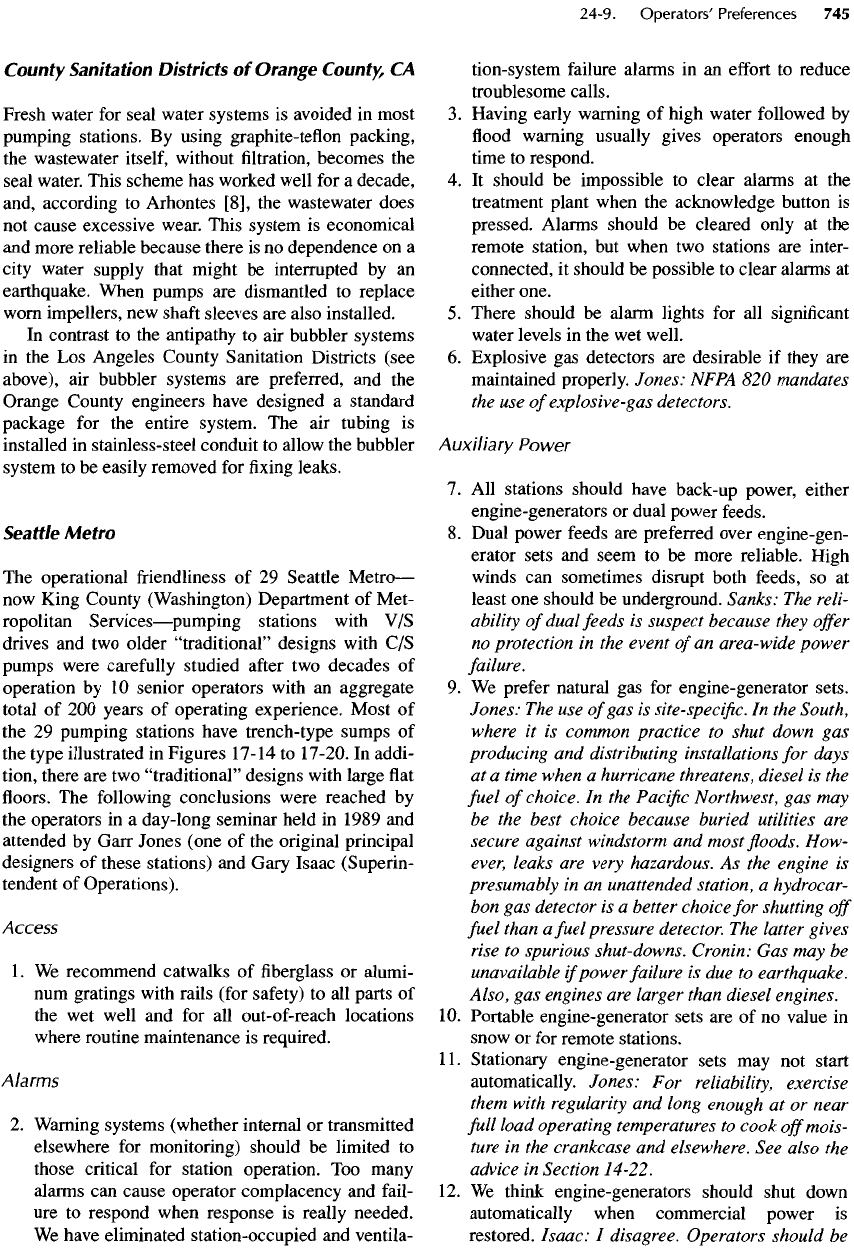
County
Sanitation
Districts
of
Orange
County,
CA
Fresh water
for
seal water systems
is
avoided
in
most
pumping
stations.
By
using graphite-teflon packing,
the
wastewater itself, without filtration, becomes
the
seal water. This scheme
has
worked well
for a
decade,
and,
according
to
Arhontes [8],
the
wastewater does
not
cause
excessive
wear. This system
is
economical
and
more reliable because there
is no
dependence
on a
city
water supply that might
be
interrupted
by an
earthquake. When pumps
are
dismantled
to
replace
worn
impellers,
new
shaft
sleeves
are
also installed.
In
contrast
to the
antipathy
to air
bubbler systems
in
the Los
Angeles County Sanitation Districts (see
above),
air
bubbler systems
are
preferred,
and the
Orange County engineers have designed
a
standard
package
for the
entire system.
The air
tubing
is
installed
in
stainless-steel conduit
to
allow
the
bubbler
system
to be
easily removed
for fixing
leaks.
Seattle
Metro
The
operational friendliness
of 29
Seattle
Metro
—
now
King County (Washington) Department
of
Met-
ropolitan
Services
—
pumping
stations with
V/S
drives
and two
older
"traditional"
designs with
C/S
pumps
were carefully studied
after
two
decades
of
operation
by 10
senior operators with
an
aggregate
total
of 200
years
of
operating
experience.
Most
of
the
29
pumping stations have trench-type sumps
of
the
type illustrated
in
Figures
17-14
to
17-20.
In
addi-
tion,
there
are two
"traditional"
designs with large
flat
floors. The
following conclusions were reached
by
the
operators
in a
day-long seminar held
in
1989
and
attended
by
Garr
Jones (one
of the
original principal
designers
of
these stations)
and
Gary Isaac (Superin-
tendent
of
Operations).
/Access
1.
We
recommend catwalks
of fiberglass or
alumi-
num
gratings with rails (for safety)
to all
parts
of
the wet
well
and for all
out-of-reach locations
where routine maintenance
is
required.
Alarms
2.
Warning systems (whether internal
or
transmitted
elsewhere
for
monitoring) should
be
limited
to
those critical
for
station operation.
Too
many
alarms
can
cause
operator
complacency
and
fail-
ure
to
respond when response
is
really
needed.
We
have eliminated station-occupied
and
ventila-
tion-system failure alarms
in an
effort
to
reduce
troublesome calls.
3.
Having early warning
of
high water followed
by
flood
warning usually gives operators enough
time
to
respond.
4. It
should
be
impossible
to
clear alarms
at the
treatment plant when
the
acknowledge button
is
pressed.
Alarms should
be
cleared
only
at the
remote station,
but
when
two
stations
are
inter-
connected,
it
should
be
possible
to
clear alarms
at
either one.
5.
There should
be
alarm lights
for all
significant
water
levels
in the wet
well.
6.
Explosive
gas
detectors
are
desirable
if
they
are
maintained properly. Jones:
NFPA
820
mandates
the use
of
explosive
-gas
detectors.
Auxiliary Power
7. All
stations should have back-up power, either
engine-generators
or
dual power feeds.
8.
Dual power feeds
are
preferred over engine-gen-
erator sets
and
seem
to be
more reliable. High
winds
can
sometimes disrupt both feeds,
so at
least
one
should
be
underground.
Sanks:
The
reli-
ability
of
dual feeds
is
suspect because
they
offer
no
protection
in the
event
of
an
area-wide
power
failure.
9. We
prefer natural
gas for
engine-generator sets.
Jones:
The use
of
gas is
site-specific.
In the
South,
where
it is
common practice
to
shut down
gas
producing
and
distributing installations
for
days
at a
time when
a
hurricane
threatens,
diesel
is the
fuel
of
choice.
In the
Pacific
Northwest,
gas may
be
the
best choice because buried utilities
are
secure
against windstorm
and
most
floods.
How-
ever,
leaks
are
very
hazardous.
As the
engine
is
presumably
in an
unattended station,
a
hydrocar-
bon gas
detector
is a
better choice
for
shutting
off
fuel
than
a
fuel pressure detector.
The
latter gives
rise
to
spurious shut-downs. Cronin:
Gas may be
unavailable
if
power
failure
is due to
earthquake.
Also,
gas
engines
are
larger
than diesel engines.
10.
Portable engine-generator sets
are of no
value
in
snow
or for
remote
stations.
11.
Stationary engine-generator sets
may not
start
automatically. Jones:
For
reliability, exercise
them
with regularity
and
long enough
at or
near
full
load operating temperatures
to
cook
off
mois-
ture
in the
crankcase
and
elsewhere.
See
also
the
advice
in
Section 14-22.
12. We
think
engine-generators
should shut down
automatically
when commercial power
is
restored. Isaac:
I
disagree. Operators should
be
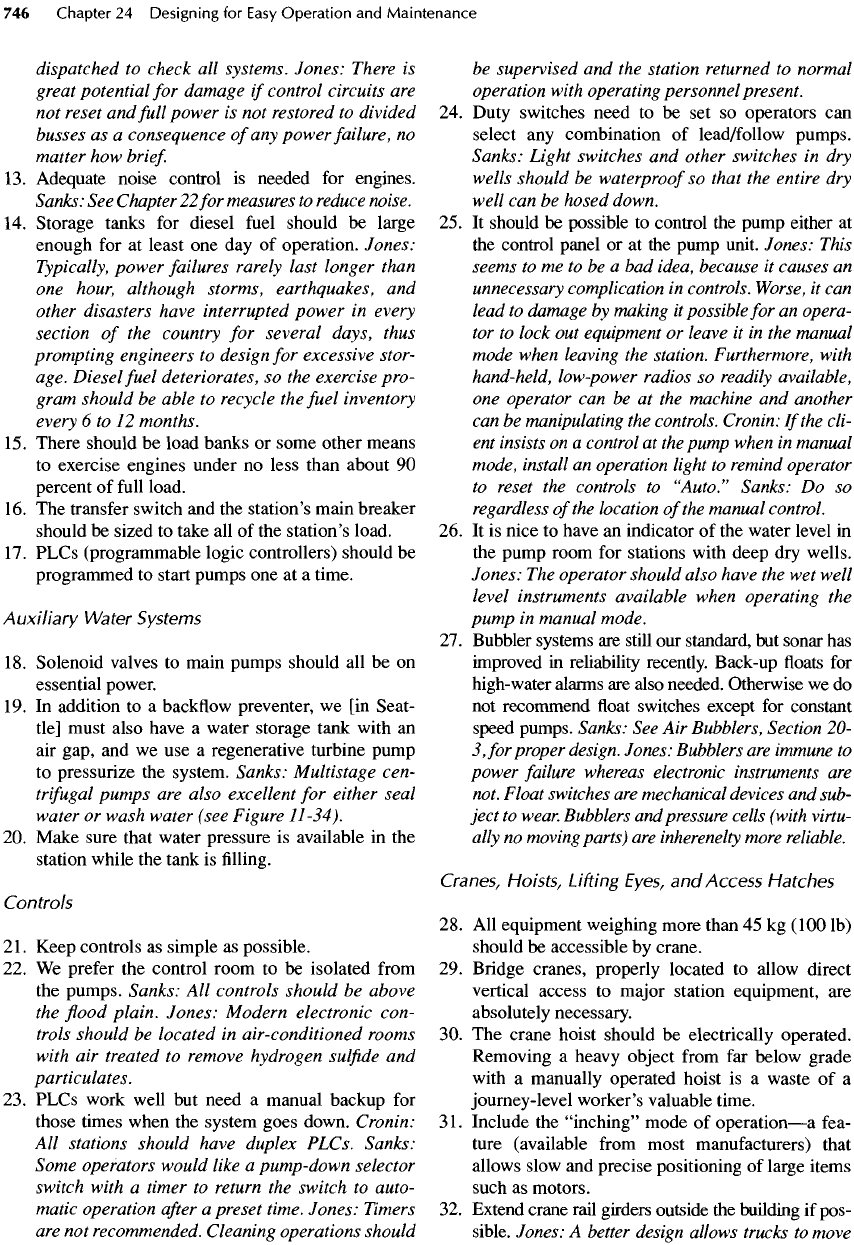
dispatched
to
check
all
systems. Jones: There
is
great
potential
for
damage
if
control circuits
are
not
reset
and
full
power
is not
restored
to
divided
busses
as a
consequence
of
any
power
failure,
no
matter
how
brief.
13.
Adequate noise control
is
needed
for
engines.
Sanks:
See
Chapter
22 for
measures
to
reduce
noise.
14.
Storage tanks
for
diesel
fuel
should
be
large
enough
for at
least
one day of
operation. Jones:
Typically,
power failures
rarely
last longer than
one
hour, although storms, earthquakes,
and
other
disasters have interrupted power
in
every
section
of the
country
for
several days, thus
prompting
engineers
to
design
for
excessive stor-
age. Diesel fuel deteriorates,
so the
exercise pro-
gram should
be
able
to
recycle
the
fuel inventory
every
6 to 12
months.
15.
There
should
be
load banks
or
some
other
means
to
exercise engines under
no
less than about
90
percent
of
full
load.
16.
The
transfer switch
and the
station's main breaker
should
be
sized
to
take
all of the
station's
load.
17.
PLCs (programmable logic
controllers)
should
be
programmed
to
start pumps
one at a
time.
Auxiliary Water Systems
18.
Solenoid valves
to
main pumps should
all be on
essential power.
19.
In
addition
to a
backflow
preventer,
we [in
Seat-
tle]
must also have
a
water storage tank with
an
air
gap,
and we use a
regenerative turbine pump
to
pressurize
the
system. Sanks: Multistage cen-
trifugal
pumps
are
also excellent
for
either seal
water
or
wash water (see Figure
11-34).
20.
Make sure that water pressure
is
available
in the
station
while
the
tank
is filling.
Controls
21.
Keep controls
as
simple
as
possible.
22. We
prefer
the
control room
to be
isolated
from
the
pumps. Sanks:
All
controls should
be
above
the
flood
plain.
Jones: Modern electronic con-
trols
should
be
located
in
air-conditioned rooms
with
air
treated
to
remove hydrogen
sulfide
and
particulates.
23.
PLCs work well
but
need
a
manual backup
for
those times when
the
system goes down. Cronin:
All
stations should have duplex PLCs. Sanks:
Some
operators would like
a
pump-down selector
switch with
a
timer
to
return
the
switch
to
auto-
matic
operation
after
a
preset time. Jones: Timers
are
not
recommended. Cleaning operations should
be
supervised
and the
station returned
to
normal
operation
with operating
personnel
present.
24.
Duty switches need
to be set so
operators
can
select
any
combination
of
lead/follow pumps.
Sanks:
Light switches
and
other switches
in dry
wells
should
be
waterproof
so
that
the
entire
dry
well
can be
hosed down.
25. It
should
be
possible
to
control
the
pump either
at
the
control panel
or at the
pump unit. Jones:
This
seems
to me to be a bad
idea, because
it
causes
an
unnecessary
complication
in
controls.
Worse,
it can
lead
to
damage
by
making
it
possible
for an
opera-
tor to
lock
out
equipment
or
leave
it in the
manual
mode
when leaving
the
station. Furthermore, with
hand-held,
low-power radios
so
readily
available,
one
operator
can be at the
machine
and
another
can be
manipulating
the
controls. Cronin:
If
the
cli-
ent
insists
on a
control
at the
pump when
in
manual
mode,
install
an
operation light
to
remind
operator
to
reset
the
controls
to
"Auto."
Sanks:
Do so
regardless
of
the
location
of
the
manual control.
26. It is
nice
to
have
an
indicator
of the
water level
in
the
pump room
for
stations with deep
dry
wells.
Jones:
The
operator should also have
the wet
well
level
instruments available when operating
the
pump
in
manual mode.
27.
Bubbler systems
are
still
our
standard,
but
sonar
has
improved
in
reliability recently. Back-up
floats for
high-
water
alarms
are
also needed. Otherwise
we do
not
recommend
float
switches except
for
constant
speed pumps. Sanks:
See Air
Bubblers, Section
20-
3, for
proper
design. Jones: Bubblers
are
immune
to
power
failure
whereas
electronic
instruments
are
not.
Float switches
are
mechanical devices
and
sub-
ject
to
wear.
Bubblers
and
pressure
cells
(with
virtu-
ally
no
moving parts)
are
inherenelty
more reliable.
Cranes,
Hoists,
Lifting
Eyes,
and
Access
Hatches
28. All
equipment weighing more than
45 kg
(100
Ib)
should
be
accessible
by
crane.
29.
Bridge cranes, properly located
to
allow direct
vertical
access
to
major station equipment,
are
absolutely necessary.
30. The
crane hoist should
be
electrically operated.
Removing
a
heavy object
from
far
below grade
with
a
manually operated hoist
is a
waste
of a
journey-level worker's valuable time.
3
1
.
Include
the
"inching"
mode
of
operation
—
a
fea-
ture (available
from
most manufacturers) that
allows slow
and
precise positioning
of
large items
such
as
motors.
32.
Extend crane rail girders outside
the
building
if
pos-
sible. Jones:
A
better
design
allows
trucks
to
move
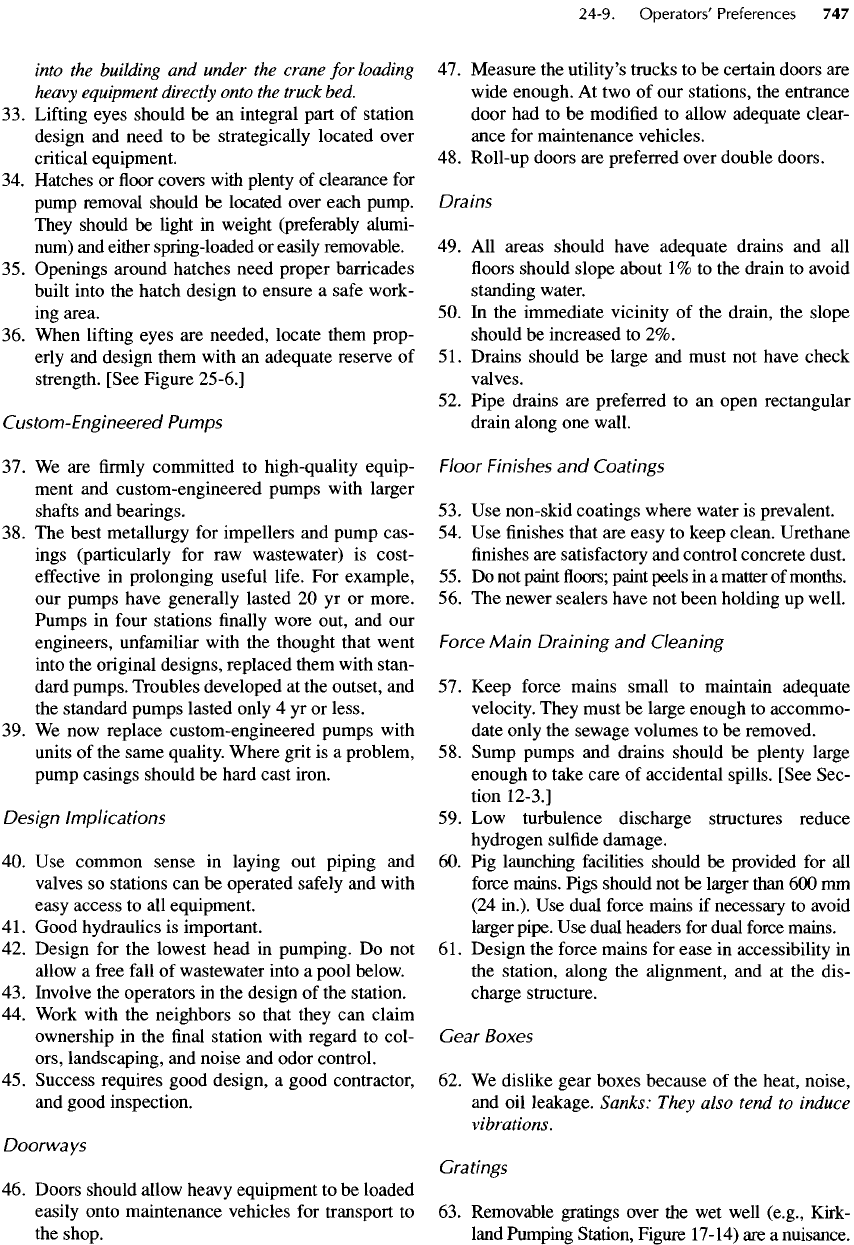
into
the
building
and
under
the
crane
for
loading
heavy
equipment
directly
onto
the
truck
bed.
33.
Lifting
eyes should
be an
integral part
of
station
design
and
need
to be
strategically located over
critical equipment.
34.
Hatches
or floor
covers
with
plenty
of
clearance
for
pump
removal should
be
located over each pump.
They should
be
light
in
weight (preferably alumi-
num)
and
either spring-loaded
or
easily removable.
35.
Openings around hatches need proper barricades
built
into
the
hatch design
to
ensure
a
safe
work-
ing
area.
36.
When
lifting
eyes
are
needed, locate them prop-
erly
and
design them with
an
adequate
reserve
of
strength. [See Figure
25-6.]
Custom-Engineered
Pumps
37. We are firmly
committed
to
high-quality equip-
ment
and
custom-engineered pumps with larger
shafts
and
bearings.
38. The
best metallurgy
for
impellers
and
pump cas-
ings
(particularly
for raw
wastewater)
is
cost-
effective
in
prolonging
useful
life.
For
example,
our
pumps have generally lasted
20 yr or
more.
Pumps
in
four
stations
finally
wore out,
and our
engineers,
unfamiliar
with
the
thought that went
into
the
original designs, replaced them with stan-
dard
pumps. Troubles developed
at the
outset,
and
the
standard pumps lasted only
4 yr or
less.
39. We now
replace custom-engineered pumps with
units
of the
same quality. Where grit
is a
problem,
pump
casings should
be
hard cast iron.
Design Implications
40. Use
common sense
in
laying
out
piping
and
valves
so
stations
can be
operated
safely
and
with
easy access
to all
equipment.
41.
Good hydraulics
is
important.
42.
Design
for the
lowest head
in
pumping.
Do not
allow
a
free
fall
of
wastewater into
a
pool below.
43.
Involve
the
operators
in the
design
of the
station.
44.
Work with
the
neighbors
so
that they
can
claim
ownership
in the final
station with regard
to
col-
ors, landscaping,
and
noise
and
odor control.
45.
Success requires good design,
a
good contractor,
and
good inspection.
Doorways
46.
Doors should allow heavy equipment
to be
loaded
easily onto maintenance vehicles
for
transport
to
the
shop.
47.
Measure
the
utility's trucks
to be
certain doors
are
wide
enough.
At two of our
stations,
the
entrance
door
had to be
modified
to
allow adequate clear-
ance
for
maintenance vehicles.
48.
Roll-up doors
are
preferred over double doors.
Drains
49. All
areas should have adequate drains
and all
floors
should slope about
1%
to the
drain
to
avoid
standing water.
50. In the
immediate vicinity
of the
drain,
the
slope
should
be
increased
to 2%.
51.
Drains should
be
large
and
must
not
have
check
valves.
52.
Pipe
drains
are
preferred
to an
open rectangular
drain
along
one
wall.
Floor
Finishes
and
Coatings
53. Use
non-skid coatings where water
is
prevalent.
54. Use finishes
that
are
easy
to
keep clean.
Urethane
finishes are
satisfactory
and
control concrete dust.
55. Do not
paint
floors;
paint peels
in a
matter
of
months.
56. The
newer
sealers
have
not
been
holding
up
well.
Force
Main
Draining
and
Cleaning
57.
Keep force mains small
to
maintain adequate
velocity. They must
be
large enough
to
accommo-
date only
the
sewage volumes
to be
removed.
58.
Sump pumps
and
drains should
be
plenty large
enough
to
take care
of
accidental spills. [See Sec-
tion
12-3.]
59. Low
turbulence discharge structures reduce
hydrogen
sulfide
damage.
60. Pig
launching facilities should
be
provided
for all
force
mains. Pigs should
not be
larger than
600 mm
(24
in.).
Use
dual
force
mains
if
necessary
to
avoid
larger
pipe.
Use
dual headers
for
dual
force
mains.
61.
Design
the
force mains
for
ease
in
accessibility
in
the
station, along
the
alignment,
and at the
dis-
charge structure.
Gear
Boxes
62. We
dislike gear boxes because
of the
heat,
noise,
and
oil
leakage. Sanks:
They
also tend
to
induce
vibrations.
Gratings
63.
Removable gratings over
the wet
well (e.g., Kirk-
land
Pumping Station, Figure 17-14)
are a
nuisance.
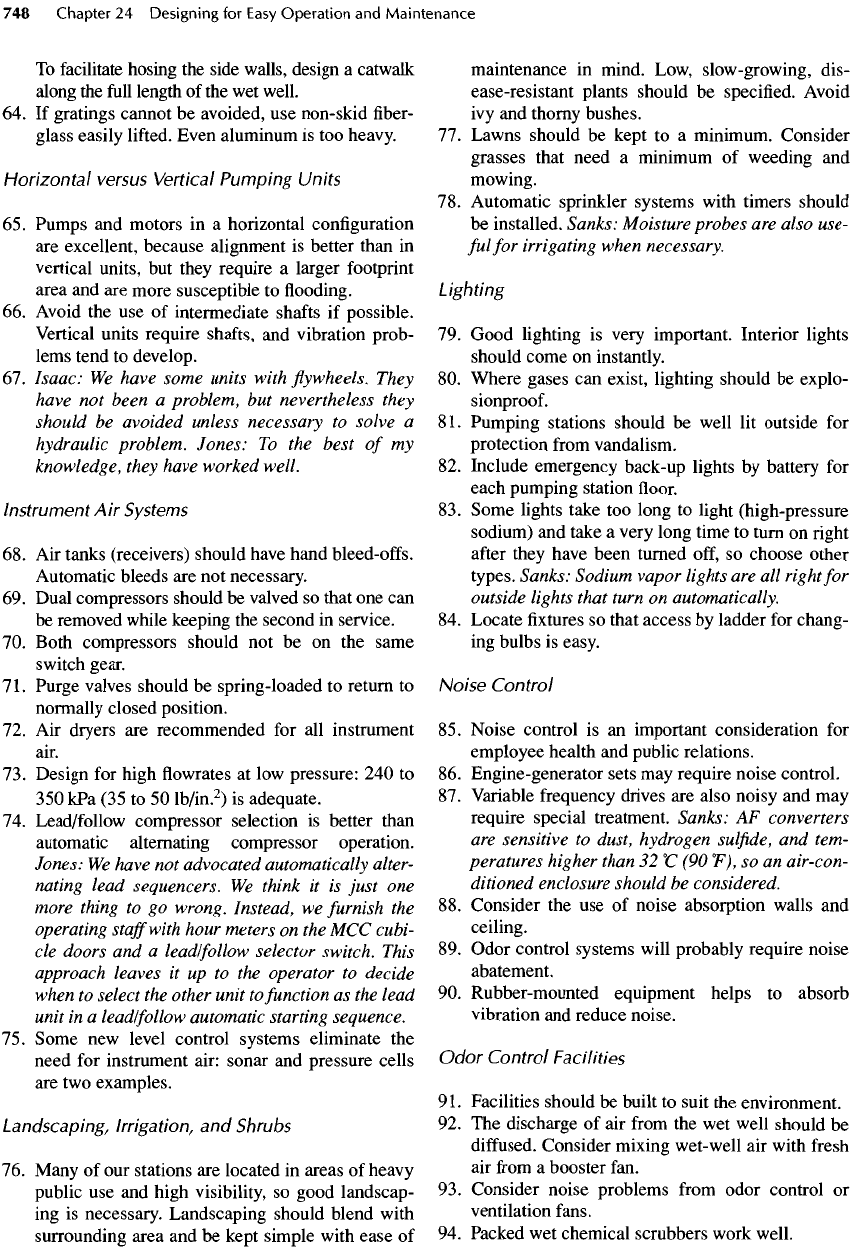
To
facilitate hosing
the
side walls, design
a
catwalk
along
the
full
length
of the wet
well.
64. If
gratings cannot
be
avoided,
use
non-skid
fiber-
glass easily
lifted.
Even aluminum
is too
heavy.
Horizontal versus Vertical Pumping Units
65.
Pumps
and
motors
in a
horizontal configuration
are
excellent, because alignment
is
better than
in
vertical units,
but
they require
a
larger footprint
area
and are
more susceptible
to flooding.
66.
Avoid
the use of
intermediate
shafts
if
possible.
Vertical
units require
shafts,
and
vibration prob-
lems tend
to
develop.
67.
Isaac:
We
have some units with
flywheels.
They
have
not
been
a
problem,
but
nevertheless
they
should
be
avoided unless necessary
to
solve
a
hydraulic
problem. Jones:
To the
best
of my
knowledge,
they
have worked well.
Instrument
Air
Systems
68. Air
tanks (receivers) should have hand
bleed-off
s.
Automatic
bleeds
are not
necessary.
69.
Dual compressors should
be
valved
so
that
one can
be
removed while keeping
the
second
in
service.
70.
Both compressors should
not be on the
same
switch gear.
71.
Purge valves should
be
spring-loaded
to
return
to
normally
closed
position.
72. Air
dryers
are
recommended
for all
instrument
air.
73.
Design
for
high
flowrates at low
pressure:
240 to
350
kPa
(35 to 50
lb/in.
2
)
is
adequate.
74.
Lead/follow compressor selection
is
better than
automatic
alternating compressor operation.
Jones:
We
have
not
advocated
automatically
alter-
nating
lead
sequencers.
We
think
it is
just
one
more
thing
to go
wrong. Instead,
we
furnish
the
operating
staff
with hour meters
on the MCC
cubi-
cle
doors
and a
lead!
follow
selector switch.
This
approach
leaves
it up to the
operator
to
decide
when
to
select
the
other unit
to
function
as the
lead
unit
in a
lead!
follow
automatic starting sequence.
75.
Some
new
level control systems eliminate
the
need
for
instrument air: sonar
and
pressure cells
are two
examples.
Landscaping,
Irrigation,
and
Shrubs
76.
Many
of our
stations
are
located
in
areas
of
heavy
public
use and
high visibility,
so
good landscap-
ing
is
necessary. Landscaping should blend with
surrounding
area
and be
kept simple with ease
of
maintenance
in
mind. Low, slow-growing, dis-
ease-resistant plants should
be
specified. Avoid
ivy
and
thorny bushes.
77.
Lawns should
be
kept
to a
minimum. Consider
grasses that need
a
minimum
of
weeding
and
mowing.
78.
Automatic sprinkler systems with timers should
be
installed.
Sanks:
Moisture probes
are
also use-
ful
for
irrigating when necessary.
Lighting
79.
Good lighting
is
very important. Interior lights
should come
on
instantly.
80.
Where gases
can
exist, lighting should
be
explo-
sionproof.
81.
Pumping stations should
be
well
lit
outside
for
protection
from
vandalism.
82.
Include emergency back-up lights
by
battery
for
each pumping station
floor.
83.
Some lights take
too
long
to
light (high-pressure
sodium)
and
take
a
very long time
to
turn
on
right
after
they have been turned off,
so
choose other
types. Sanks: Sodium vapor lights
are all
right
for
outside
lights that turn
on
automatically.
84.
Locate
fixtures so
that access
by
ladder
for
chang-
ing
bulbs
is
easy.
Noise
Control
85.
Noise control
is an
important consideration
for
employee health
and
public relations.
86.
Engine-generator sets
may
require noise control.
87.
Variable frequency drives
are
also noisy
and may
require special treatment. Sanks:
AF
converters
are
sensitive
to
dust, hydrogen
sulfide,
and
tem-
peratures higher than
32
0
C
(90
0
F),
so an
air-con-
ditioned
enclosure should
be
considered.
88.
Consider
the use of
noise absorption walls
and
ceiling.
89.
Odor control systems will probably require noise
abatement.
90.
Rubber-mounted equipment helps
to
absorb
vibration
and
reduce noise.
Odor
Control Facilities
91.
Facilities should
be
built
to
suit
the
environment.
92. The
discharge
of air
from
the wet
well should
be
diffused.
Consider mixing
wet-
well
air
with
fresh
air
from
a
booster fan.
93.
Consider noise problems
from
odor control
or
ventilation
fans.
94.
Packed
wet
chemical scrubbers work well.
